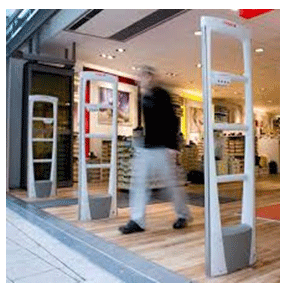 Police Departments across the nation are busy this holiday season launching operations aiming at catching shoplifters. Serial shoplifters go from store to store stealing hundreds of dollars worth of merchandise from each store. Police and retailers alike have been working together to stop this vicious and financially crippling crime. Shoplifters are not necessarily from the area where they commit their crime, there are serial shoplifters that go from state to state, and from store to store, stealing as much as they can. For a retailer, the hundreds of dollars stolen from their store is a financial burden, and jeopardizes their ability to stay open for business.
Police Departments across the nation are busy this holiday season launching operations aiming at catching shoplifters. Serial shoplifters go from store to store stealing hundreds of dollars worth of merchandise from each store. Police and retailers alike have been working together to stop this vicious and financially crippling crime. Shoplifters are not necessarily from the area where they commit their crime, there are serial shoplifters that go from state to state, and from store to store, stealing as much as they can. For a retailer, the hundreds of dollars stolen from their store is a financial burden, and jeopardizes their ability to stay open for business.
For more about this and other stories, follow the links below.
How local law enforcement are working to stop organized retail crime
BUFFALO, N.Y.–
Organized retail crime is rising across the country, according to the National Retail Federation. In Western New York, local law enforcement said they’re constantly working to stop it.
“They’ll steal goods and products from various stores, sometimes taking orders,” Officer Craig Johnson, field intelligence officer for the Amherst Police Department, said. Johnson said organized shoplifting rings operate locally and even statewide.
“[They’ll go] down the thru way through the major cities, Albany, Syracuse, Rochester, Buffalo, even to Erie, Pennsylvania,” he said. HE said the thieves use stolen ID’s and credit cards to rent cars. They’ll even sometimes steal a license plate from another car to put on their rental. Then they spend hours stealing from stores, including items like clothing, medication, baby formula and even appliances. They then move on to another city by the time law enforcement is notified.
“They could be from different states. They could be from downstate New York. It’s very hard to find out that information of who these people are,” Johnson said.
Serial Shoplifters Target Burlington Stores
It was a busy day for Amanda Bean. First, she stole several hundred dollars’ worth of merchandise from a store that shares her surname — L.L.Bean. Burlington police cited her for retail theft and released her. Two hours later, Bean allegedly stole goods valued at several hundred dollars from the Skirackon Main Street. Bean was again charged with retail theft and let go.
Since that day in April, Bean, 33, of St. Albans, pleaded guilty to the L.L.Bean theft, but her stealing apparently hasn’t stopped. She has been arrested on similar charges twice — including on October 22, while she was serving a community-based furlough for the L.L.Bean theft. All told, Bean has been arrested more than 20 times and has at least nine retail theft convictions, along with convictions for other crimes.
Downtown merchants are frustrated with frequent fliers like Bean. While other crimes such as burglary are declining in Burlington, retail theft is escalating, police say. Between 2012 and 2015, annual retail theft calls to Burlington police increased from 341 to 423. This year, the trend continued. The number of calls between January and November 1, 2016, totaled 404, compared to 374 over the same time period last year.
‘Operation Blitz’ To Target Professional Shoplifters
MINNEAPOLIS (WCCO) — As we look to get started on our holidayshopping lists, police will be looking for professional shoplifters.
Beginning on Black Friday, more than 30 Twin Cities law enforcementagencies will launch “Operation Blitz.”
The first-of-its-kind partnership in the state will target organized retail theft and financial fraud.
Police showed WCCO how these professionals do their best to avoid detection.
Take what police say happened at a St. Paul CVS two weeks ago, when a man walked in with a gym bag and loaded it with cleaning supplies. He was out of the store in under 40 seconds.
 It’s official folks. It’s December and the year is almost over. It also means that you’ve probably hired some additional help around the store. Whether they be temporary, part-time or full-time employees, they all have one thing in common; they have the potential to steal from you. I hate to sound so cynical, but I’m a realist. With December historically being the biggest month for internal theft, I’d thought I’d share some of my tips on how to spot a potential dishonest employee.
It’s official folks. It’s December and the year is almost over. It also means that you’ve probably hired some additional help around the store. Whether they be temporary, part-time or full-time employees, they all have one thing in common; they have the potential to steal from you. I hate to sound so cynical, but I’m a realist. With December historically being the biggest month for internal theft, I’d thought I’d share some of my tips on how to spot a potential dishonest employee. The holiday season is officially under way and your stress level is about to go into overload. When we’re overly stressed bad things happen to us mentally, emotionally and physically: headaches, digestive issues, eating too much, concentration problems, decreased impulse control, increased emotional sensitivity, poor planning ability and sleep disturbances.
The holiday season is officially under way and your stress level is about to go into overload. When we’re overly stressed bad things happen to us mentally, emotionally and physically: headaches, digestive issues, eating too much, concentration problems, decreased impulse control, increased emotional sensitivity, poor planning ability and sleep disturbances.
 Step back and take a hard look. Or better yet ask someone you trust to do that. A friend, another business owner…… they really do not need to have any special skills. You should look at your store from the prospective of the shoplifter. If you were going to steal, how would you do it? Do you have dark areas, high shelving, hidden spots that would make the thief comfortable? Is your store unkempt, dirty and not stocked in an organized way? Shoplifters are attracted to these environments. If you are presenting that look, then the shoplifter probably knows you are not able to keep up or simply do not care. This will also breed more shoplifting as word gets around that YOUR STORE is an easy mark.
Step back and take a hard look. Or better yet ask someone you trust to do that. A friend, another business owner…… they really do not need to have any special skills. You should look at your store from the prospective of the shoplifter. If you were going to steal, how would you do it? Do you have dark areas, high shelving, hidden spots that would make the thief comfortable? Is your store unkempt, dirty and not stocked in an organized way? Shoplifters are attracted to these environments. If you are presenting that look, then the shoplifter probably knows you are not able to keep up or simply do not care. This will also breed more shoplifting as word gets around that YOUR STORE is an easy mark.
 Are they asleep at the switch? Do they care? Have you trained them how you want the shoplifting deterrence program in your store to work and what their roll in it is? This is not something you can put off. It’s like saving money in an account. You got to start. If you are one of Loss Prevention Systems Customers already, then you know this. That is why we conduct live, personalized shoplifting prevention and loss prevention training for our customers.
Are they asleep at the switch? Do they care? Have you trained them how you want the shoplifting deterrence program in your store to work and what their roll in it is? This is not something you can put off. It’s like saving money in an account. You got to start. If you are one of Loss Prevention Systems Customers already, then you know this. That is why we conduct live, personalized shoplifting prevention and loss prevention training for our customers.  This is the best time for retailers. We make a good chunk of our profits during the last 3 months of our fiscal year. Walk into any major retailer right now and you’ll already see a litany of holiday themed gifts, home décor and all things red and green. We also tend to beef up our staff this time of year as well. Some of us hire part-time works, some may even add a full-time position or two and a great many of us will employ temporary workers. The threat of employee theft also peaks around this time as well.
This is the best time for retailers. We make a good chunk of our profits during the last 3 months of our fiscal year. Walk into any major retailer right now and you’ll already see a litany of holiday themed gifts, home décor and all things red and green. We also tend to beef up our staff this time of year as well. Some of us hire part-time works, some may even add a full-time position or two and a great many of us will employ temporary workers. The threat of employee theft also peaks around this time as well.  As I sit here on this Halloween night, thinking about how great it was when I was a kid to pillage the neighborhoods for candy and treats, I can’t help but also think about the next 60 days. The real fright comes now for all of us in the retail game. We’ve got so little time to do so very much. We all have new receipts pouring in, plan-o-grams that need setting, bulk stacks that need stacking and bins that need filling; all with the mad hopes of grabbing every possible dollar from now until December 24. A big part of that plan, for most, is hiring temporary help to get us through. Have you ever thought about how these temporary workers can impact your LP goals? With a little training and guidance, they can be one of your greatest holiday assets.
As I sit here on this Halloween night, thinking about how great it was when I was a kid to pillage the neighborhoods for candy and treats, I can’t help but also think about the next 60 days. The real fright comes now for all of us in the retail game. We’ve got so little time to do so very much. We all have new receipts pouring in, plan-o-grams that need setting, bulk stacks that need stacking and bins that need filling; all with the mad hopes of grabbing every possible dollar from now until December 24. A big part of that plan, for most, is hiring temporary help to get us through. Have you ever thought about how these temporary workers can impact your LP goals? With a little training and guidance, they can be one of your greatest holiday assets. Ever given any thought to your receiving area and your back door? How often do you open it and walk away? Do you require a manager be present when it’s open, or do you “trust” your warehouse crew with a key? Have you ever considered that an unattended back door could not only cause shrink, but also compromise the safety of your customer and employees? If you answered yes to any of those questions, you may have a problem.
Ever given any thought to your receiving area and your back door? How often do you open it and walk away? Do you require a manager be present when it’s open, or do you “trust” your warehouse crew with a key? Have you ever considered that an unattended back door could not only cause shrink, but also compromise the safety of your customer and employees? If you answered yes to any of those questions, you may have a problem. It is not surprising that CVS is once again the recipient of a lawsuit.
It is not surprising that CVS is once again the recipient of a lawsuit.
